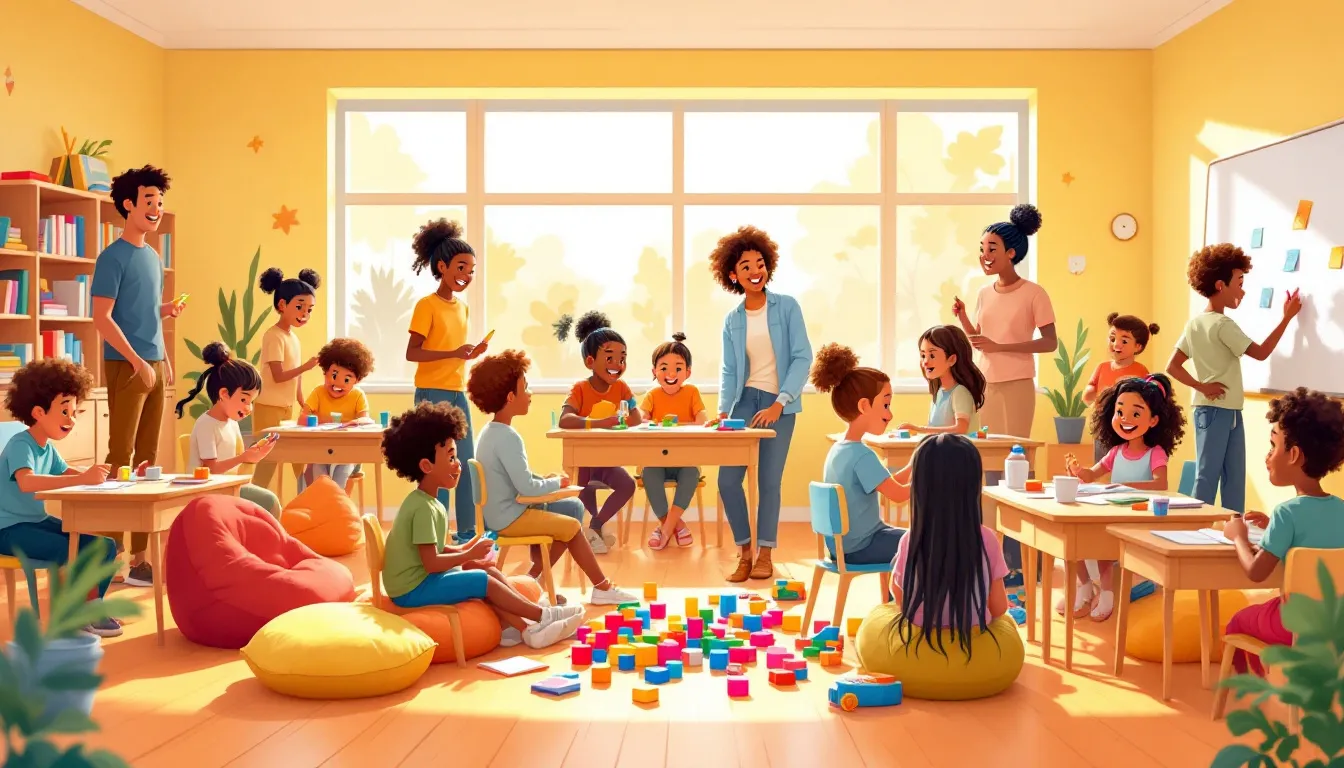Rubrics are game-changers for grading student work fairly and clearly. Here's what you need to know:
- Rubrics are scoring guides that spell out expectations for assignments
- They keep grading consistent, clear, and efficient
- Different types of rubrics serve various grading needs:
- Holistic rubrics: Quick overall assessment
- Analytic rubrics: Detailed feedback on specific criteria
- Single-point rubrics: Focus on meeting expectations
- Performance-based rubrics: Assess real-world skills
- AI-enhanced rubrics: Save time and improve consistency
Good rubrics:
- Show students what's expected
- Make grading fair across assignments and teachers
- Give specific feedback for improvement
- Save teachers time while improving assessments
Bottom line: Rubrics are essential tools for effective teaching and learning. They turn vague goals into measurable points, helping students know what to do and often leading to better work.
Quick Comparison:
| Rubric Type | Speed | Detail | Flexibility | Best For |
|---|---|---|---|---|
| Holistic | Fast | Low | High | Quick assessments |
| Analytic | Slow | High | Medium | Complex assignments |
| Single-point | Medium | Medium | High | Focused feedback |
| Performance-based | Medium | High | Medium | Real-world tasks |
| AI-enhanced | Fast | High | High | Consistent grading |
1. Holistic Rubrics
Holistic rubrics are the quick and dirty of grading tools. They give you one score for the whole shebang, instead of picking apart every little detail.
Why are they cool? Let's break it down:
1. They're fast
You can whip through a stack of assignments like nobody's business. One score, boom, done. It's a lifesaver when you're drowning in papers.
2. They focus on the good stuff
Instead of nitpicking every mistake, holistic rubrics look at what students did right. It's like giving a high-five instead of a red pen massacre.
3. They're flexible
Essays, art projects, interpretive dance - holistic rubrics can handle it all. They're great when the whole package matters more than the individual parts.
4. They keep things fair
When multiple teachers are grading the same thing, holistic rubrics help keep everyone on the same page. It's like having a shared grading language.
But hey, they're not perfect:
- Students might be left scratching their heads, wondering why they got a certain score.
- It can be tricky to score work that's awesome in some ways but not so hot in others.
Here's a simple holistic rubric for a history essay:
| Score | What it means |
|---|---|
| 4 | Nailed it. Great history knowledge, clear arguments, well-organized, no typos. |
| 3 | Pretty good. Solid history, mostly clear, organized, a few minor mistakes. |
| 2 | Meh. Basic history, some confusing parts, needs better organization, several errors. |
| 1 | Needs work. Limited history understanding, unclear, messy, lots of mistakes. |
Holistic rubrics are perfect for quick checks or when you want to see the big picture without getting lost in the weeds.
As one teacher put it, "Holistic rubrics show what students CAN do, not what they can't." It's like giving a pat on the back instead of a punch in the gut.
2. Analytic Rubrics
Analytic rubrics are like a detailed map for grading. They break assignments into specific parts, giving students a clear picture of what's expected. Here's why they're so useful:
These rubrics are perfect for complex tasks where you want to give detailed feedback. They let you zoom in on each important part of an assignment. Think of a history essay - you might grade research, argument structure, and writing style separately.
Dr. Dana Dawson from Temple University says:
"Taking the time to reflect on your goals for an activity or assignment and to concretely articulate your expectations will not only improve the quality of the rubric you create, but will help guide your instruction."
Why use analytic rubrics? They offer:
- Specific feedback: Students know exactly what they did well and where to improve.
- Fair grading: Every part of the assignment gets attention.
- Clear learning goals: Students see which skills they need to work on.
But watch out - these rubrics can get complicated. Most use 3-5 levels for each criteria. Don't go overboard, or you might confuse students instead of helping them.
Here's a tip: Weight different parts of your rubric based on how important they are. This shows students where to focus for the biggest grade impact.
Creating an analytic rubric takes some work upfront, but it's worth it. You'll set clearer expectations and help students learn more effectively. To make one, start by listing what a great assignment looks like. Then, group similar items to create your rubric categories.
3. Single-Point Rubrics
Single-point rubrics are shaking up the grading game. They're simple, focused, and getting a lot of love from teachers.
What's the deal with single-point rubrics? They show what success looks like for each part of an assignment. No fancy levels or long descriptions. Just the target.
Why are teachers digging these? Here's the scoop:
- Quick to make. Teachers focus on the good stuff, not all the ways students might mess up.
- Easy to read. Students see what they need to do without getting lost in details.
- Room for creativity. No boxes to check means students can surprise you.
- Growth-focused. It's about progress, not labels.
Jennifer Gonzalez, an educator and blogger, says:
"The simplicity of these rubrics - with just a single column of criteria, rather than a full menu of performance levels - offers a whole host of benefits."
Let's check out a real example. Here's part of a single-point rubric for second-grade writing:
| Criteria | Areas for Improvement | Meets Expectations | Areas of Excellence |
|---|---|---|---|
| Opening | Begins with a greeting, includes recipient's name, uses a comma after the greeting. | ||
| Body | Writes at least three sentences to express ideas or ask questions, stays on the topic of the letter, uses appropriate sentence structure and vocabulary. |
Clear as day, right? Kids know exactly what to do.
But here's the cool part: Those blank spaces on the sides? That's where teachers give specific, personalized feedback. No generic comments here.
Pernille Ripp, an educator and author, puts it this way:
"Using the single-point rubric is a breeze for me compared to the multi-point rubric."
So, if you want to simplify grading and still give great feedback, single-point rubrics might be your new go-to. They're clear, flexible, and all about helping students grow.
sbb-itb-bb2be89
4. Performance-Based Rubrics
Performance-based rubrics are tools that assess how well students can use their knowledge in real-world situations. They're not just about checking facts - they're about seeing how students apply what they've learned.
Why are these rubrics so useful? Here's the deal:
They test real-world skills. It's not about memorizing - it's about doing.
They make students think harder. We're talking analysis, evaluation, and creation.
They set clear goals. Both teachers and students know what "good" looks like.
They give specific feedback. Students learn exactly where they're strong and where they need work.
Philip Arcuria and Maryrose Chaaban, who know a thing or two about grading, say:
"A carefully designed rubric can provide benefits to instructors and students alike."
They're right. A good performance-based rubric makes grading fair, saves time, and shows students how to improve.
Let's look at a real example:
A Boston high school math teacher created a rubric for a probability unit in March 2022. The task? Decide if an inmate should get parole based on stats. Talk about bringing math into the real world!
Here's a simple version of that rubric:
| Criteria | Beginner (1) | Proficient (2) | Expert (3) |
|---|---|---|---|
| Data Analysis | Tries to interpret data, makes big mistakes | Gets most data points right | Nails all data, spots key trends |
| Statistical Reasoning | Uses basic probability ideas, limited understanding | Applies probability correctly most times | Shows advanced probability understanding in decisions |
| Conclusion | Reaches a conclusion with little data support | Supports conclusion with some data | Gives a solid conclusion backed by full data analysis |
This rubric isn't just checking math skills. It's seeing if students can analyze data, use statistical concepts, and make smart decisions based on evidence. That's the power of these rubrics - they connect classroom learning to real problem-solving.
When you're making your own performance-based rubrics:
- Match them to your learning goals
- Be clear about what success looks like
- Use words you and your students get
- Focus on stuff you can see and measure
Performance-based rubrics take grading to the next level. They show what students can DO, not just what they know. And in the end, isn't that what learning is all about?
5. AI-Enhanced Rubrics
AI-powered rubric generators are changing how teachers create and use grading criteria. These tools save time and make student assessment more consistent. Let's look at a standout example:
CoGrader: AI-Powered Rubric Creation
CoGrader is shaking up rubric creation for teachers. Here's why it's turning heads:
- It cuts rubric creation time by 80%
- It aligns with Grade Level Standards
- Teachers can adjust AI-generated rubrics or make their own
- It offers over 30 pre-made rubrics
But the real impact is on teachers and students. Nikki E., a high school English teacher from California, says:
"CoGrader's qualitative feedback is spot-on. It's so precise, it's mind-blowing. It saves me time, and my students get more thorough feedback than if I were grading by hand."
This shows that AI-enhanced rubrics aren't just about saving time. They're about giving better, more detailed feedback to help students improve.
By using AI, teachers can create rubrics that are:
- Consistent: AI applies grading criteria the same way for all student work
- Detailed: It can create nuanced performance descriptors for each criterion
- Aligned: Rubrics can easily match specific learning goals and standards
AI-enhanced rubrics like those from CoGrader are becoming a key tool for teachers. They're not replacing human judgment – they're making it better. This allows teachers to give fairer, clearer, and more helpful feedback to their students.
Conclusion
Rubrics have changed the game in student assessment. They bring fairness and clarity to grading. We've looked at different types of rubrics, from basic to AI-powered. It's clear: these tools are must-haves for teachers and students alike.
Good rubrics do a lot:
- They show students exactly what's expected
- They make grading fair across different assignments and teachers
- They give students specific feedback to improve
- They save teachers time while making assessments better
Amy Pinkerton from the Center for Teaching and Learning says:
"Rubrics are useful tools that faculty and teaching assistants can use to give their students clear and consistent feedback."
This clarity is key. Rubrics turn vague goals like "good writing" into specific, measurable points. This helps students know what to do and often leads to better work.
But rubrics do more than just help with one assignment. They can improve how we design courses, teach, and understand student learning. They shift focus from teacher-centered grading to student-centered feedback that boosts achievement.
Check out these results:
- AI tools like CoGrader can cut grading time by up to 80%
- Students feel less stressed when they know what's expected
- Rubrics can boost students' confidence by showing them what skills they need
Remember, making good rubrics is an ongoing job. Linda Suskie, who wrote "Assessing Student Learning: A Common Sense Guide", puts it this way:
"Rubrics make scoring more accurate, unbiased, and consistent."
To keep this up, teachers need to keep tweaking their rubrics based on how students do and what they say.
FAQs
What does a good rubric look like?
A good rubric is like a GPS for academic success. It pinpoints exactly what students need to do to excel. Here's the secret sauce of a top-notch rubric:
- It spells out clear criteria
- It describes different performance levels
- It uses student-friendly language
- It focuses on measurable outcomes
Philip Arcuria and Maryrose Chaaban, assessment gurus, put it this way:
"The best rubrics will typically include specific criteria relevant to the task or assignment at hand, as well as a set of descriptors that outline the different levels of performance that learners may achieve."
Let's get real with an example. Picture grading a history essay. Your rubric might look like this:
| Criteria | Beginner (1) | Proficient (2) | Expert (3) |
|---|---|---|---|
| Historical Accuracy | Major factual errors | Minor errors | Spot-on, well-researched |
| Argument Structure | Fuzzy logic | Clear arguments, some evidence | Rock-solid arguments throughout |
| Writing Style | Grammar gremlins galore | Few oopsies | Polished prose, error-free |
This rubric paints a clear picture of what's expected at each level. It's specific, measurable, and easy to grasp.
But here's the kicker: a good rubric isn't just about slapping on a grade. It's a teaching powerhouse. Susan M. Brookhart, a big shot in classroom assessment, says:
"What do effective rubrics look like? They're more than just a checklist, but rather guidelines that focus on skills that demonstrate learning."
So, next time you're whipping up a rubric, think about how it can steer learning, not just measure it. Your students (and your sanity) will do a happy dance!


